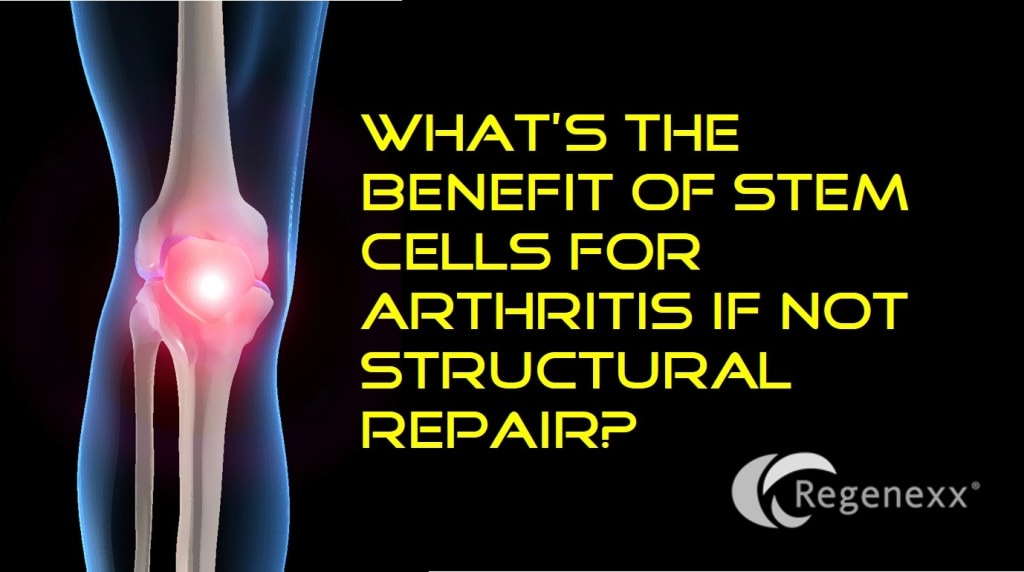What’s the Benefit of Stem Cells for Arthritis if Not Structural Repair?
What’s the Benefit of Stem Cells for Arthritis if not Structural Repair? This is a question from a twitter follower that I thought was so important but complex, that trying to answer in 140 characters or less would be impossible. Patients are often lead to believe that a stem cell injection used to treat moderate to severe knee arthritis has the expectation of regrowing large amounts of new cartilage. This is usually not the case, but despite this many patients get prolonged relief. Why? To understand this better you first have to understand why arthritis hurts in the first place.
First, what is arthritis? Based on what we can see on x-rays and MRIs, it’s a progressive loss of cartilage that leads to changes in the bone (i.e. bone spurs) that’s caused by excessive and prolonged inflammation. Physicians and patients alike have been lead to believe that arthritis hurts because of lost cartilage. Like many messages in medicine, the simple ones are easiest to explain to patients, but regrettably the truth is often way more complex.
So what’s the truth about cartilage and pain? Despite a multi-billion dollar industry that exists to try to diagnose and treat lost cartilage, the most recent high level research shows that there is no relationship between lost cartilage and pain. Huh? How could that be you ask? Everything from my radiology report from my MRI to my orthopedic surgeon seems hyper focused on my cartilage! Regrettably, since these are new discoveries, most of these providers haven’t yet gotten the memo.
So if cartilage loss doesn’t cause arthritis pain, what does? That’s where the simple explanation gets more complex. For example, we know that problems in the bone (BMLs) that are easily seen on MRI can cause pain. We also know that bad inflammatory chemicals in the joint are better predictors of pain. We know that patients with knee arthritis have problems in the nerves from the spinal cord to the knee. Finally, we know that cells inside the arthritic knee get activated and begin wrecking havoc.
In many types of orthopedic problems we commonly see big structural changes with stem cell injections. A good example is with a torn ACL ligament in the knee. In patients who have mild arthritis with a pothole, we’ve seen evidence on MRI that stem cell injections can help heal the defect. However, in patients with big time cartilage loss and severe arthritis, the changes we see on MRI are less dramatic, usually limited to improvements in BMLs without evidence of widespread cartilage regrowth. However, many of these patients with severe arthritis do very well with treatment, so what explains the changes? Here’s what we know (each link below is to a short video explaining the concept):
- Stem cells can block the cells that are literally eating away at the joint (activated marcrophages).
- Stem cells release many helpful growth factors for the joint, essentially becoming tiny little medicine factories.
- Stem cells can hijack the helpful protein making ability of other cells, getting them to become tiny little medicine factories.
- Stem cells can revive the batteries (mitochondria) of dying cells by transferring some of their good batteries to the troubled cell.
- Lastly, stem cells can morph into cell types that are needed in the arthritic joint, a process called differentiation.
The upshot? Stem cells can help severely arthritic joints in many ways. The fact that they don’t regenerate large stretches of cartilage isn’t likely a big deal, since cartilage loss isn’t causing your pain and lost function!

If you have questions or comments about this blog post, please email us at [email protected]
NOTE: This blog post provides general information to help the reader better understand regenerative medicine, musculoskeletal health, and related subjects. All content provided in this blog, website, or any linked materials, including text, graphics, images, patient profiles, outcomes, and information, are not intended and should not be considered or used as a substitute for medical advice, diagnosis, or treatment. Please always consult with a professional and certified healthcare provider to discuss if a treatment is right for you.

